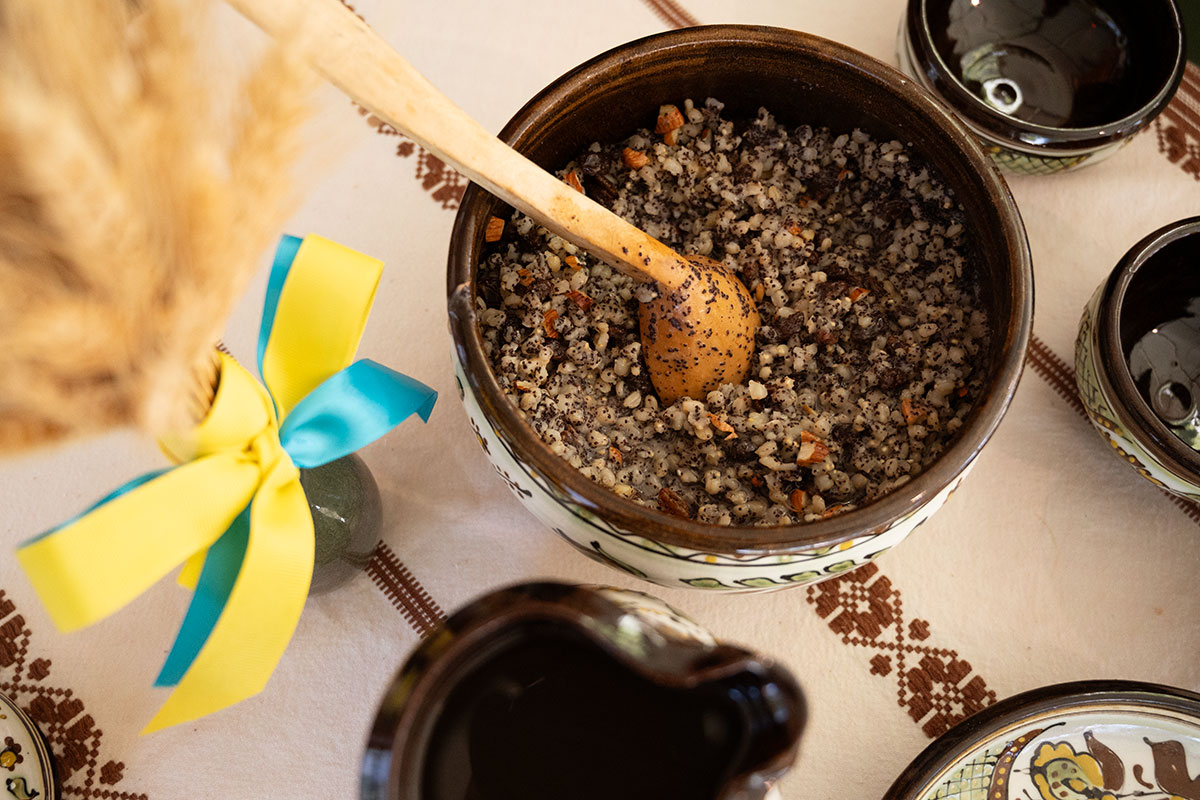Before Ukrainians accepted Christianity in 988, the winter solstice in late December was a time to worship their ancestors. They believed that the sky “opened” at this time—allowing animals to talk, humans to predict the future, and their deceased relatives to return from the “other world” to Earth, where they could protect their descendants and help maintain traditional customs and rites.
In many cases, the adoption of Christianity assimilated pagan traditions. For example, the birth of the new sun at solstice became combined with the celebration of Christmas, signaling the birth of Jesus Christ and the first star rising in the sky. Christmas Eve became the time when many families started preparing to welcome their deceased ancestors, especially with two main ceremonial dishes, kutia (sweetened wheat berry dish) and uzvar (dried fruit beverage), known as “food of the gods.”
On Christmas Eve, most Ukrainians do not eat until evening—and then not until after watching the first star rise in the sky. Whoever first sees the star will be happy the whole year. Afterward, relatives and friends fill the house with the aroma of fragrant herbs, light a candle, and pray for their deceased relatives. Then they pray for the living, wishing everyone good health and happiness until next Christmas. They may also pray for those who are lost or in captivity, paying their respects to those in need.

Traditionally, there should always be twelve meatless dishes served for svyata vecherya, or Christmas Eve dinner. The number corresponds to the twelve apostles, and the food is meatless out of respect for the animals in the nativity scene. But the two most important dishes—and first consumed—are kutia and uzvar.
Kutia comes with elaborate rituals. The head of the household throws one spoonful of kutia to the ceiling, and everyone looks to see how many grains have stuck: many grains mean there will be a bountiful harvest and happiness for the family. Another spoonful is thrown to the window, as a donation to the frost, to prevent the crops from freezing. Ukrainians traditionally give one part of the kutia dish to their cattle and save another for children to give to their godparents and grandparents when they greet each other and receive gifts.
Ukrainians prepare uzvar by boiling dried fruits, especially apples, plums, and pears, and then adding honey, nuts, and raisins. Everything is mixed in a deep ceramic bowl, which they place for “penance” under the religious icons in a “holy corner” of the house. However, they also save some uzvar to drink after the first taste of kutia, which family members eat from one bowl. They eat the other dishes afterward. Following the meal on Christmas Eve, groups of children go to other houses, singing carols that are both Christian and pre-Christian.
Ukrainian Christmas traditions—like preparing kutia and uzvar among the twelve dishes, and exchanging gifts—are highly symbolic. These traditions pay respect not only to deceased ancestors but also to living relatives and friends, displaying the vibrant cultural heritage and vivid national identity of contemporary Ukraine.

Recipe: Kutia (Sweetened Wheat Berries)
Ingredients
500 grams hard white winter wheat berries
1.5–2 liters water
200 grams poppy seeds
150 grams honey
200 grams raisins
300 grams toasted walnuts
100 grams sugar
Preparation
Soak the wheat berries in water overnight.
The following day, drain them and boil them in 1.5 to 2 liters of water for approximately 2 hours, stirring occasionally and adding water as needed. Once soft, drain completely.
Rinse the poppy seeds, then soak in boiled hot water for around 30 minutes. Drain them, and grind them with a wooden pestle or makohin in a ceramic bowl or blitz them in a blender with the sugar.
Soak the raisins in hot water for just a few minutes. Drain and rinse.
Finely chop the walnuts. Combine all ingredients in a bowl and stir well, adding honey to taste.
If you’ve made uzvar as well, add the beverage to cover the kutia.
Recipe: Uzvar (Dried Fruit Beverage)
Ingredients
500 grams total dried smoked apples, pears, and/or apricots
100 grams dried prunes
200 grams sugar
3–4 liters water
Preparation
Soak the dried fruit in water overnight.
In a pot, bring water to a boil. Add the dried fruit and prunes and boil for 15 minutes. Mix well. Then cover, set aside, and allow to cool.
Traditionally, uzvar is served in a ceramic jug.

Tetiana Poshyvailo is a cultural anthropologist and art critic, serving as deputy director of the Ivan Honchar Museum (National Centre of Folk Culture) in Kyiv, Ukraine. She was a participant— demonstrating Ukrainian foodways—at the 2023 Smithsonian Folklife Festival.


